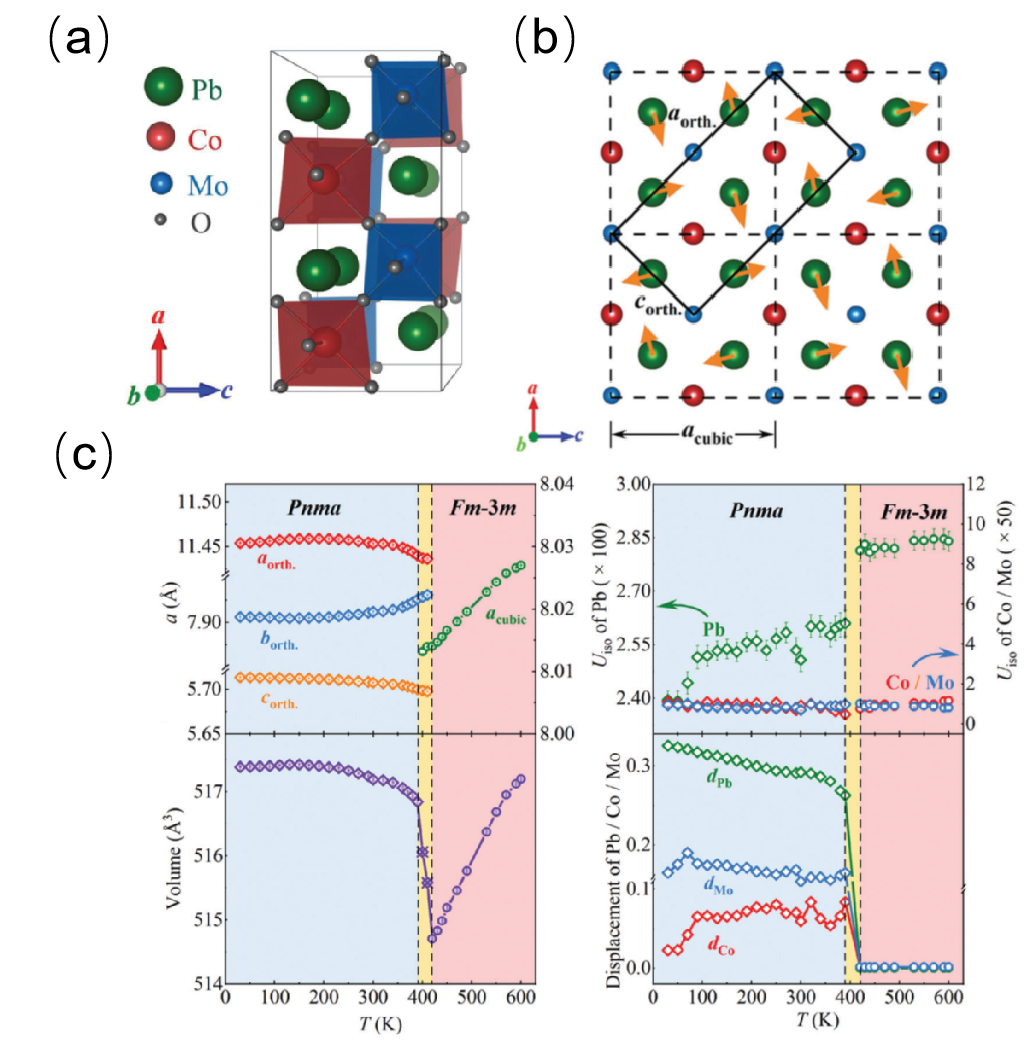New research from a team of scientists co-led by Dr. Runze Yu from HPSTAR observed an antiferroelectricity-induced negative thermal expansion for the first time in double perovskite Pb2CoMoO6. This study is published in the journal of Small and selected as frontispiece.
Negative thermal expansion (NTE) materials have attracted extensive attention in recent decades owing to their intriguing physical properties and potential applications in optical instruments, precise machining equipment, advanced electronics, and fuel cells. Compared to common materials that generally exhibit positive thermal expansion (PTE) arising from the anharmonic vibration of atoms, NTE materials exhibit counterintuitive thermal shrinkage upon heating, that is, the coefficient of thermal expansion is negative. As a result, NTE materials can be used to counteract thermal expansion by forming composites with PTE materials or to realize controllable thermal expansion in single phase materials via chemical substitution to obtain zero thermal expansion (ZTE).
In recent years, materials with unconventional thermal expansion have been developed rapidly. Among them, ferroelectricity induced NTE, which can be quantitatively described by spontaneous volume ferroelectrostriction, has been widely studied. Generally, NTE occurs during the ferroelectric-to-paraelectric or ferroelectric-to-antiferroelectric phase transitions, whereas it is has never been observed in an antiferroelectric-to-paraelectric phase transition by now.
In the material Pb2CoMoO6, Yu and colleagues found NTE for the first time induced by antiferroelectric-to-paraelectric phase transition. In this study, single-crystal and polycrystalline Pb2CoMoO6 samples are synthesized at high pressure and temperature conditions. The compound crystallizes in an antiferroelectric Pnma orthorhombic double perovskite structure at room temperature owing to the opposite displacements dominated by Pb2+ ions. With increasing temperature to 400 K, a structural phase transition to cubic Fm-3m paraelectric phase occurs, accompanied by a sharp volume contraction of 0.41%. This is the first report of an antiferroelectric-to-paraelectric transition-induced NTE in Pb2CoMoO6. Moreover, the compound also exhibits remarkable NTE with an average volumetric coefficient of thermal expansion of−1.33 × 10−5 K−1 in a wide temperature range of 30–420 K. The as-prepared Pb2CoMoO6 can serve as a unique material for studying antiferroelectricity-induced NTE based on a new mechanism.

Caption: (a) Crystal structure of Pb2CoMoO6 at 300K. (b) Schematic Pb2+atomic displacements in the ac plane for Pb2CoMoO6. (c)Temperature dependence of lattice parameters, unit cell volumes, atomic thermal parameters, and atomic displacements as determined using SXRD data for Pb2CoMoO6.
热胀冷缩是一种普遍存在的自然现象,但该效应在工程与器件应用上有时会带来破坏作用。负热膨胀材料随温度变化表现出反常的“热缩冷胀”行为,可通过负热膨胀材料与正常热膨胀材料的复合设计制备体积不随温度变化的材料体系,从而避免因热膨胀效应导致的相关器件失效。因此,负热膨胀材料在光学仪器、精密加工、先进电子学等领域具有广阔的应用前景。然而,目前已知的单相负热膨胀材料仍然有限,开发具有新颖负热膨胀机制的新型材料至关重要。北京高压科学研究中心(HPSTAR)于润泽课题组与北中国科学院物理研究所的龙有文等国内外团队合作,利用高压高温实验手段成功制备了一种具有反铁电结构的双钙钛矿材料Pb2CoMoO6,该材料在400K左右发生由低温正交Pnma反铁电相到高温立方Fm-3m顺电相的结构相变,并伴随着明显的体积收缩,这是反铁电-顺电相变诱导负热膨胀的首次报道。Pb2CoMoO6 提供了一个研究反铁电性诱导负热膨胀的范例,为探索和发现新的负热膨胀材料和机理提供了新思路。相关结果于近期以“Antiferroelectricity‐Induced Negative Thermal Expansion in Double Perovskite Pb2CoMoO6”为题发表于Small,并被选为卷首插页文章(frontispiece)。
